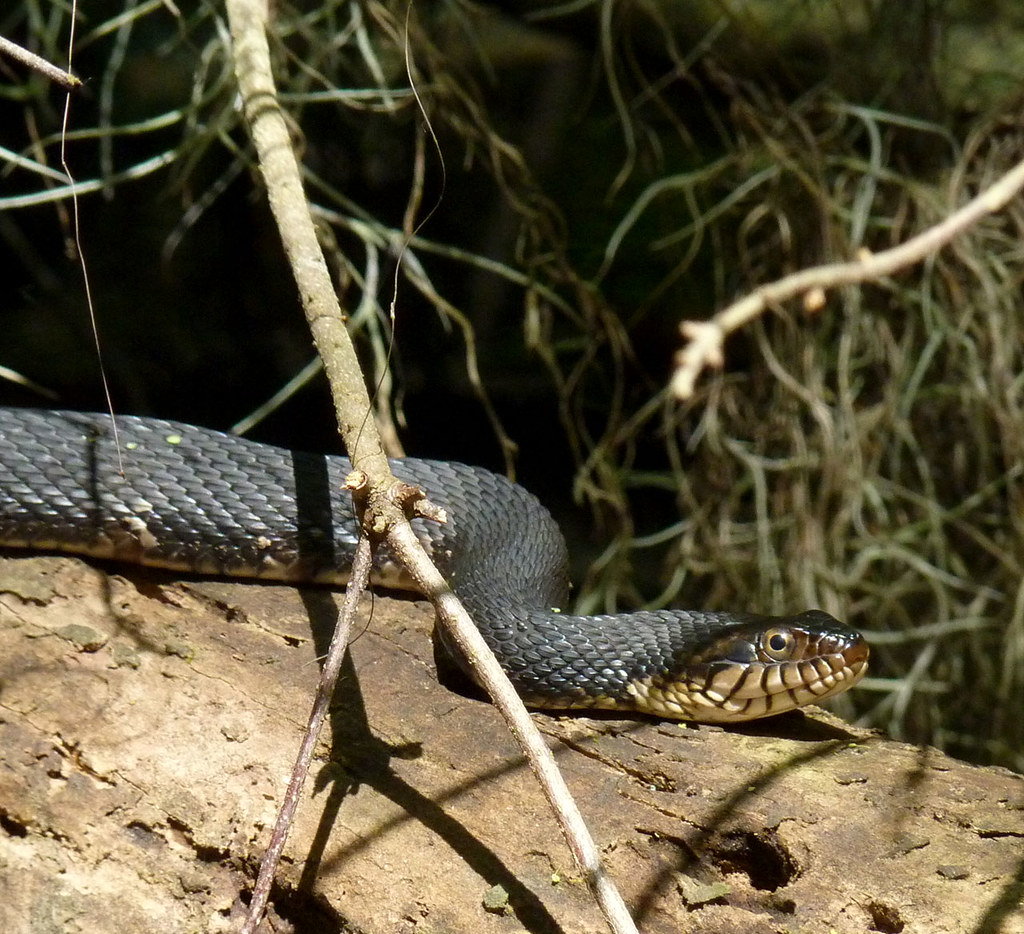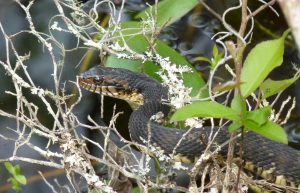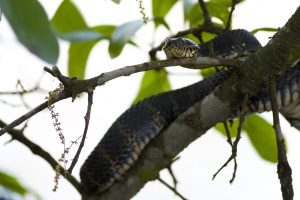In Florida, we have 46 native species of snakes. Thankfully, only 6 of those species are venomous. In Central Florida, we have 35 of Florida’s native snake species and only 4 of the 6 venomous species found in the state. Thanks to Hollywood and common folklore, a fear of snakes is incredibly common today. However, snakebite deaths are incredibly rare and encounters with venomous snakes can often be avoided or minimized so that a bite is unlikely.
What’s the difference between venomous and poisonous?
Venom must be injected into your body where it will come in contact with your circulatory system, whereas poison needs to be touched, inhaled, or ingested for it to be harmful. Therefore, snakes described here are venomous … not poisonous.
As a reminder, both venomous and non-venomous snakes can bite and both types of bites require medical attention. While a non-venomous snake bite is unlikely to be a severe medical condition, it is important to seek medical treatment to prevent infection and subsequent medical issues that can result from infection.
Both venomous snakes and non-venomous snakes generally prefer to avoid confrontation and humans. You are far too big, even as a child, to be considered prey. If a snake bites you, it is because it felt threatened in some way.
The venomous snakes found in Central Florida are:
- Eastern Diamond-backed Rattlesnake (Crotalus adamanteus)
- Pygmy Rattlesnake (Sistrurus miliarius)
- Cottonmouth or Water Moccasin (Agkistrodon piscivorous)
- Coralsnake (Micrurus fulvius)
The diamond-backed rattlesnake is easy to identify by the yellow or gold outlined black diamonds on its back. The pygmy rattlesnake, the cottonmouth, and the coralsnake all have native, non-venomous lookalikes. Some of these lookalikes are very good imitators!
The majority of photos sent in for identification to the Natural Resources Extension Program in Polk County are of suspected cottonmouths. Much more often than not, the snake in question is actually a southern or banded watersnake (Nerodia fasciata).
None of the following photos are a Cottonmouth or Water Moccasin. All of the following photos is of the southern or banded watersnake, which is non-venomous and native to Florida.
Take some time to look at these two species and you’ll notice a few differences.
- The cottonmouth has a spade shaped head that is much larger than the watersnake’s head. However, be aware that when threatened, the watersnake may attempt to flatten it’s head and mimic the cottonmouth’s head shape. See this behavior here:
- The banded watersnake has a round pupil and a relatively large eye

“Banded Water Snake, south Georgia, USA” by TomSpinker is licensed under CC BY-NC-ND 2.0 - The cottonmouth is more “heavy-bodied” or more muscular looking than the banded water snake (In other words, the cottonmouth has a thicker body)
- The banded watersnake has a scale pattern on its bottom jaw that looks like long, fang-like teeth but don’t worry … they are just dark scales.

To learn more about the visual differences between these species, watch this short video from UF/IFAS Pinellas County Extension: https://youtu.be/J9mNGKjcbas
What to do if you encounter a snake in your yard or at your home
Generally speaking, snakes (both venomous and non-venomous) are more interested in escaping than attacking. To reduce the chance of a snakebite give all snakes plenty of room to escape. You are much more likely to get bitten if you attempt to capture, kill, or handle a snake than if you slowly back away and create an escape route.
Snakes provide a lot of benefit to society by eating some of our least desired pest species like rats, mice, and insects. Have native, non-venomous snakes in your yard or landscape should be seen as a blessing, not a curse, because they are helping reduce pest populations. If you would prefer to make your yard less desirable to snakes, see the recommendations made in the UF/IFAS Wildlife publication, “Dealing with Snakes in Florida’s Residential Areas—Preventing Encounters.”
If having the snake in your yard concerns you, or if there is a snake in your home, consider calling a professional wildlife trapper to deal with it. It is safer for you and your loved ones to have a professional trapper come out than for you or a family member, friend, or neighbor to try and capture, kill, or handle the snake. Florida Fish and Wildlife Conservation Commission maintains a list of wildlife trappers, here: https://public.myfwc.com/HGM/NWT/NWTSearch.aspx
Snakebite Emergency Planning
In the unlikely event that you or a someone you are with is bitten by a venomous snake, there are some simple first aid DOs and DON’Ts to remember.
If travelling or participating in outdoor recreation, you should have a snake bite emergency plan. It is important to make sure everyone in your group knows the proper first aid for a snakebite and understands that the best “snakebite kit” available on the market is simply your cell phone.
What TO DO:
- Seek medical attention as soon as possible. Dial 911 or call local Emergency Medical Services (EMS).
- Apply first aid if you cannot get the person to the hospital right away – but DO NOT delay seeking medical treatment!
- Lay or sit the person down with the bite below the level of the heart.
- Tell him/her to stay calm and still.
- Wash the wound with warm soapy water immediately.
- Cover the bite with a clean, dry dressing.
- Remove bracelets, rings, and constrictive clothing – swelling is likely.
- Write down the estimated time of the snake bite and any symptoms that occur as you await medical treatment.
What NOT TO DO:
- Do not wait for symptoms to show to seek medical attention. Seek medical attention as soon as possible, not all snake bite symptoms are obvious.
- Do not pick up the snake or try to trap it (this may put you or someone else at risk for a bite).
- There are 2 basic types of antivenin – for Coralsnakes or pit vipers (rattlesnakes, Cottonmouth, Copperhead). If possible, write down a basic description of the snake that caused the bite to help doctors decide which antivenin to use.
- Do not apply a tourniquet.
- Do not slash the wound with a knife OR attempt to suck out the venom.
- Your cell phone is your best snakebite kit!
- Do not apply ice or immerse the wound in water.
- Avoid drinking alcohol or caffeinated beverages.
To learn more about common snakes in Florida:
Consider watching a webinar recording we made about Snakes in Central Florida: https://youtu.be/cWQC1FKE1io
Consider reading the blog post, “Commonly Confused Snakes in Central Florida” here: https://blogs.ifas.ufl.edu/polkco/2018/04/26/commonly-confused-snakes-in-central-florida/
Feel free to send photos to me via twitter (www.twitter.com/@polkNR). If I can’t identify the Florida snake you’ve seen, I’ll reach out to colleagues who can.
Sources:
- http://ufwildlife.ifas.ufl.edu/snakebite_emergency.shtml
- http://ufwildlife.ifas.ufl.edu/snakes/florida.shtml
- https://www.cdc.gov/disasters/snakebite.html
- http://edis.ifas.ufl.edu/uw261
- https://www.science.org.au/curious/everything-else/poison-vs-venom
- http://edis.ifas.ufl.edu/uw226
- http://edis.ifas.ufl.edu/pdffiles/UW/UW26000.pdf
If you enjoyed this series and would like to read more about commonly confused plants and animals in Florida, you can find more here:
https://blogs.ifas.ufl.edu/global/tag/commonly-confused/
Originally Published: Jul. 2019
Last Updated: Jul. 2020
University of Florida IFAS Extension is committed to diversity of people, thought and opinion, to inclusiveness and to equal opportunity.
UF/IFAS Extension is an Equal Opportunity Institution.
 0
0




